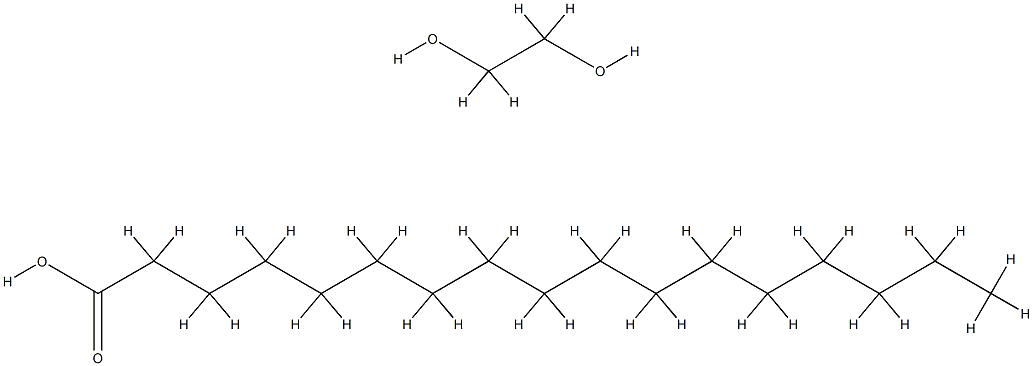Poly(ethylene glycol) distearate
Synonym(s):Polyoxyethylene bis(stearate)
- CAS NO.:9005-08-7
- Empirical Formula: C19H40O4
- Molecular Weight: 332.5185
- MDL number: MFCD00084419
- SAFETY DATA SHEET (SDS)
- Update Date: 2024-12-18 14:07:02

What is Poly(ethylene glycol) distearate?
Chemical properties
A soft, off-white solid. PH of 10% dispersion 7.26, saponification number variable. Soluble in chlorinated solvents, light esters, and acetone; slightly soluble in alcohols, insoluble in glycols, hydrocarbons, and vegetable oils. Combustible.
The Uses of Poly(ethylene glycol) distearate
POLY(ETHYLENE GLYCOL) (N) DISTEARATE is used as an emulsifier for personal care and water treatment and as a processing aid in textile industry.
The Uses of Poly(ethylene glycol) distearate
Pegosperse(R) 300 DS is used as an emulsifier for personal care and water treatment and as a processing aid in textile industry.
Definition
Distearate ester of polyglycol.
Production Methods
Polyethylene glycol distearate is prepared by the direct reaction of fatty acids, particularly stearic acid, with ethylene oxide.
Pharmaceutical Applications
Polyethylene glycol distearate is generally used as emulsifiers in oil-inwater-
type creams and lotions. Its hydrophilicity or lipophilicity
depends on the number of ethylene oxide units present: the larger
the number, the greater the hydrophilic properties. Polyoxyl 40
stearate has been used as an emulsifying agent in intravenous
infusions.
Polyoxyethylene stearates are particularly useful as emulsifying
agents when astringent salts or other strong electrolytes are present.
It can also be blended with other surfactants to obtain any
hydrophilic–lipophilic balance for lotions or ointment formulations.
Safety Profile
Poison by intravenous route. When heated to decomposition it emits acrid smoke and irritating fumes. See also POLYETHYLENE GLYCOL.
Safety
Although Polyethylene glycol distearate is primarily used as emulsifying
agents in topical pharmaceutical formulations, certain materials,
particularly polyoxyl 40 stearate, have also been used in
intravenous injections and oral preparations.
Polyethylene glycol distearate has been tested extensively for
toxicity in animals(8–13) and are widely used in pharmaceutical formulations and cosmetics. It is generally regarded as
essentially nontoxic and nonirritant materials.
Polyoxyl 8 stearate
(hamster, oral): 27 g/kg
(rat, oral): 64 g/kg
Polyoxyl 20 stearate
(mouse, IP): 0.2 g/kg
(mouse, IV): 0.87 g/kg
storage
Polyoxyethylene stearates are generally stable in the presence of electrolytes and weak acids or bases. Strong acids and bases can cause gradual hydrolysis and saponification.
The bulk material should be stored in a well-closed container, in a dry place, at room temperature.
Incompatibilities
Polyethylene glycol distearate is unstable in hot alkaline solutions owing to hydrolysis, and will also saponify with strong acids or bases. Discoloration or precipitation can occur with salicylates, phenolic substances, iodine salts, and salts of bismuth, silver, and tannins.Complex formation with preservatives may also occur.The antimicrobial activity of some materials such as bacitracin, chloramphenicol, phenoxymethylpenicillin, sodium penicillin, and tetracycline may be reduced in the presence of polyoxyethylene stearate concentrations greater than 5% w/w.
Regulatory Status
Included in the FDA Inactive Ingredients Database (dental solutions; IV injections; ophthalmic preparations; oral capsules and tablets; otic suspensions; topical creams, emulsions, lotions, ointments, and solutions; and vaginal preparations). Included in nonparenteral medicines licensed in the UK. Included in the Canadian List of Acceptable Non-medicinal Ingredients.
Properties of Poly(ethylene glycol) distearate
| Melting point: | 35-37 °C |
| Flash point: | >230 °F |
| Odor | at 100.00?%. mild waxy |
| Dielectric constant | 2.3(0.0℃) |
| CAS DataBase Reference | 9005-08-7 |
| EPA Substance Registry System | Polyethylene glycol distearate (9005-08-7) |
Safety information for Poly(ethylene glycol) distearate
Computed Descriptors for Poly(ethylene glycol) distearate
Poly(ethylene glycol) distearate manufacturer
Viswaat Chemicals Limited
Kawaken Sterling Surfactants Pvt Ltd (Sterling Group)
New Products
(S)-3-Aminobutanenitrile hydrochloride 4-Methylphenylacetic acid N-Boc-D-alaninol N-BOC-D/L-ALANINOL Tert-butyl bis(2-chloroethyl)carbamate 3-Morpholino-1-(4-nitrophenyl)-5,6-dihydropyridin- 2(1H)-one Furan-2,5-Dicarboxylic Acid Tropic acid 1-Bromo-3,5-Di-Tert-Butylbenzene S-2-CHLORO PROPIONIC ACID ETHYL ISOCYANOACETATE 2-Bromo-1,3-Bis(Dimethylamino)Trimethinium Hexafluorophosphate 4-IODO BENZOIC ACID 3-NITRO-2-METHYL ANILINE 1-(2,4-DICHLOROPHENYL) ETHANAMINE (2-Hydroxyphenyl)acetonitrile 4-Bromopyrazole 2-(Cyanocyclohexyl)acetic acid 4-methoxy-3,5-dinitropyridine 1-(4-(aminomethyl)benzyl)urea hydrochloride 2-aminopropyl benzoate hydrochloride diethyl 2-(2-((tertbutoxycarbonyl)amino) ethyl)malonate tert-butyl 4- (ureidomethyl)benzylcarbamate Ethyl-2-chloro((4-methoxyphenyl)hydrazono)acetateRelated products of tetrahydrofuran








You may like
-
 9005-08-7 Polyethyleneglycol distearate 99%View Details
9005-08-7 Polyethyleneglycol distearate 99%View Details
9005-08-7 -
 9005-08-7 98%View Details
9005-08-7 98%View Details
9005-08-7 -
 1975-50-4 98%View Details
1975-50-4 98%View Details
1975-50-4 -
 2-HYDROXY BENZYL ALCOHOL 98%View Details
2-HYDROXY BENZYL ALCOHOL 98%View Details
90-01-7 -
 2-Chloro-1,3-Bis(Dimethylamino)Trimethinium Hexafluorophosphate 221615-75-4 98%View Details
2-Chloro-1,3-Bis(Dimethylamino)Trimethinium Hexafluorophosphate 221615-75-4 98%View Details
221615-75-4 -
 61397-56-6 CIS BROMO BENZOATE 98%View Details
61397-56-6 CIS BROMO BENZOATE 98%View Details
61397-56-6 -
 14714-50-2 (2-Hydroxyphenyl)acetonitrile 98+View Details
14714-50-2 (2-Hydroxyphenyl)acetonitrile 98+View Details
14714-50-2 -
 118753-70-1 98+View Details
118753-70-1 98+View Details
118753-70-1